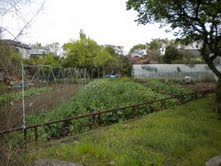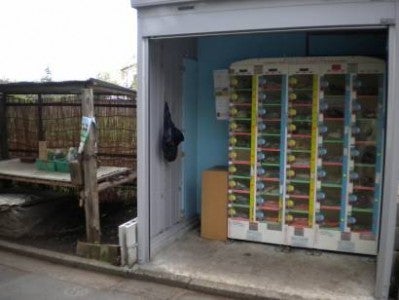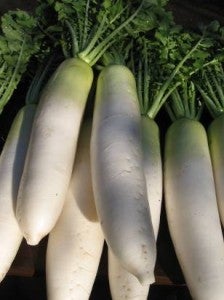Guest Article By Joan Lambert Bailey
When we moved to Tokyo last year, I thought I wouldn't see a farm again until we ventured into Japan's countryside. A booming metropolis of more than 35 million people, images of the city don't often include green much less open farm space. While it is true that there is little growing space in the city, it is still possible to come across little pockets of farms in some places.

Farm Field and Greenhouse from Bike Path
Even though our apartment is only a handful of stops past the last subway station, and commuter trains rumble by every few minutes, here on the west side of the city
a number of small farms and orchards still exist. The largest of these covers a city block, and the smallest is less than a sixteenth of that. Trellising, pruning, and intensive crop rotation are common practices no matter how big or small the growing space. While I revel in the sight of each farm whether its the size of a postage stamp or larger, what gives me even greater pleasure is the fact that many sell their vegetables directly to the public. Seasonal fruits, vegetables, and sometimes even tsukemono (pickled vegetables) can be found for the taking. Usually, it's just a small table with the vegetables, a sign, and a money box. With the exception of stands on busy thoroughfares, the farmer counts on the honor system for fair and accurate compensation for his or her vegetables. (Although,
lockers or vegetable vending machines are slowly springing up next to the fields, too!).
Other than
the farmers markets springing up all over the city, these stands are one of my favorite ways to get locally grown produce. The price is more than competitive with the grocery store or greengrocer, and I have the satisfaction of putting the money directly into the hands of the farmer. While I lean toward organic growers, on these shopping excursions I am simply happy to support the grower. The field where the carrot, broccoli, fresh greens, or daikon came from is visible from where I stand with my nearly full bicycle basket. In my book, each coin clunking in the box means the farmer has a better chance of keeping that land open for production. In a city full of cement, these farms are vital little oasis that can't be taken for granted.

Farm Stand Table and Vegetable Box
Japan Agriculture (JA) makes finding the growers and their stands that much easier for the shopper by producing
an area map showing each farm and marking the stands. One side holds a fairly detailed street map, while the other lists the farms and offers a simple chart of what is in season at different times of year. It's one of the handiest tools I've found yet for tracking down locally grown produce, and often takes me into neighborhoods where other growers and producers can be found, too. One trip resulted not only in two new kinds of Japanese radishes, but a half dozen eggs from another nearby farm!
The farm stand pictured above is one of my regular stops. It and its farm are on a bike path that runs north of our apartment building, and as the seasons change I watch the fields turn over and the vegetables rotate. During a stretch of particularly nice days this past winter, the farmer dried long thin strips of daikon on a rack in the back corner of the field. Bright green pea pods, long beans (Japan’s answer to the string bean), broccoli raab, and eggplants mark the changing seasons as do the fruit trees and herbs that line the fields and still cluster about the old farmhouse. Homemade tsukemono (Japanese pickles) can often also be found alongside the fresh vegetables, and it’s a bit of race to get a bag. The contents and flavors change with the seasons, too, and never fail to give us a delightful taste of life in Japan.

Daikon Radish
And just like at the farmer’s market, these stands make the prospect of trying an unknown vegetable that much more appealing. I’ve come home more than once with an unidentified green or vegetable along with a recipe gleaned from a fellow customer or sometimes the farmer. New favorites – satoimo (taro root), komatsuna and mizuna – graced our table all winter long in new dishes, to boot. Old favorites like cabbage, green beans, and cucumbers still have their place, but thanks to these little stands they get served up in a myriad of new ways. Mingling with the other customers – usually Japanese women of varying generations – at the stand I get to know my neighbors a bit along with their favorite recipes. Clearly the world over a farm grows not just fruit, vegetables, or meat for the table, but bonds for the surrounding community.
Joan Lambert Bailey gardens, farms, and writes in Tokyo, Japan. Read more about her food and farming adventures at Popcorn Homestead and Everyday Gardens.










 Your Privacy Choices
Your Privacy Choices
I want to to thank you for this good read!
! I certainly enjoyed every little bit of it. I’ve got you bookmarked to look at new things you post…